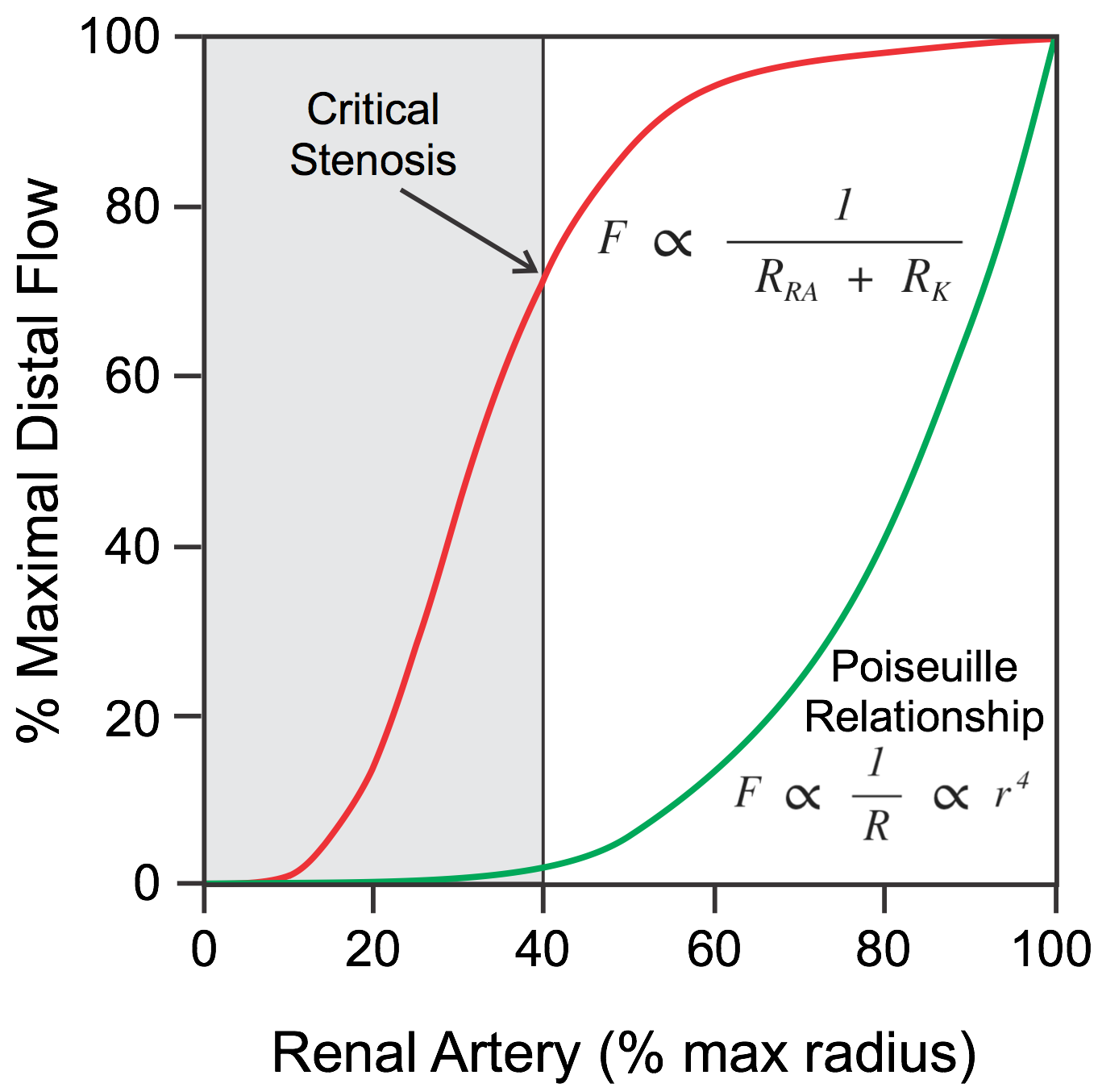Critical Stenosis
The term "stenosis" can refer to an abnormal narrowing of an artery, usually of a discrete segment, that partially obstructs blood flow. Stenosis can also refer to a reduced cross-sectional area of a heart valve when it opens. With an artery, stenosis most commonly occurs in large distributing arteries such as coronary, renal, cerebral, iliac and femoral arteries. The narrowing commonly results from a chronic disease process such as atherosclerosis. Occasionally, a vessel can become acutely stenotic because of focal vasospasm.
 Stenosis increases the resistance in a vascular segment as described by Poiseuille's equation, which says that resistance is inversely related to the diameter to the fourth power. Therefore, if the diameter (or radius) of a vascular segment is reduced by one-half, the resistance within that narrowed segment increases 16-fold. If this vascular segment were being perfused in isolation, the flow would be decreased 16-fold if perfusion pressure were held constant, as shown in the figure to the right (green line). However, in vivo, this degree of stenosis has much less effect on flow because the vessel is coupled in-series with downstream resistance vessels of the vascular bed (CLICK HERE for more information). If we consider the renal artery and kidney circulation, the resistance of a normal renal artery (RRA in figure equation) contributes to only a small fraction (<1%) of the vascular resistance of the kidney (RK). In this example, the renal artery resistance (RRA) is in series with the kidney vascular resistance (RK). Therefore, the renal artery needs to be narrowed by over 60% before overall renal vascular resistance is increased enough to decrease renal blood flow significantly (red line). This is also true for other organ circulations such as the heart, limbs, and brain.
Stenosis increases the resistance in a vascular segment as described by Poiseuille's equation, which says that resistance is inversely related to the diameter to the fourth power. Therefore, if the diameter (or radius) of a vascular segment is reduced by one-half, the resistance within that narrowed segment increases 16-fold. If this vascular segment were being perfused in isolation, the flow would be decreased 16-fold if perfusion pressure were held constant, as shown in the figure to the right (green line). However, in vivo, this degree of stenosis has much less effect on flow because the vessel is coupled in-series with downstream resistance vessels of the vascular bed (CLICK HERE for more information). If we consider the renal artery and kidney circulation, the resistance of a normal renal artery (RRA in figure equation) contributes to only a small fraction (<1%) of the vascular resistance of the kidney (RK). In this example, the renal artery resistance (RRA) is in series with the kidney vascular resistance (RK). Therefore, the renal artery needs to be narrowed by over 60% before overall renal vascular resistance is increased enough to decrease renal blood flow significantly (red line). This is also true for other organ circulations such as the heart, limbs, and brain.
The term "critical stenosis" refers to a critical narrowing of an artery (stenosis) that results in a significant reduction in maximal flow capacity in a distal vascular bed. A critical stenosis may or may not reduce resting flow depending on the organ's capacity to autoregulate its blood flow and the development of collateral blood flow, both of which reduce the overall resistance in the smaller resistance vessels. Clinically, a critical stenosis typically is thought of in terms of a 60-75% reduction in the diameter of the large distributing artery. This explains why interventional measures such as balloon angioplasty, stent placement, or arterial bypass surgery are not usually conducted in patients until there is at least a 75% reduction in vessel diameter.
Revised 11/05/2023

 Cardiovascular Physiology Concepts, 3rd edition textbook, Published by Wolters Kluwer (2021)
Cardiovascular Physiology Concepts, 3rd edition textbook, Published by Wolters Kluwer (2021) Normal and Abnormal Blood Pressure, published by Richard E. Klabunde (2013)
Normal and Abnormal Blood Pressure, published by Richard E. Klabunde (2013)